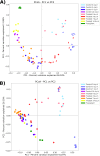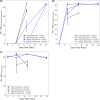Topical Application of Adult Cecal Contents to Eggs Transplants Spore-Forming Microbiota but Not Other Members of the Microbiota to Chicks
- PMID: 31862722
- PMCID: PMC7028958
- DOI: 10.1128/AEM.02387-19
Topical Application of Adult Cecal Contents to Eggs Transplants Spore-Forming Microbiota but Not Other Members of the Microbiota to Chicks
Abstract
The intestinal microbiota plays an essential role in the metabolism and immune competence of chickens from the first day after hatching. In modern production systems, chicks are isolated from adult chickens, instead hatching in a clean environment. As a result, chicks are colonized by environmental bacteria, including potential pathogens. There is a need to investigate methods by which chicks can be exposed to a more appropriate microbial community at hatching. Such methods must be easy to apply in a hatchery and produce consistent results. The development of the intestinal microbiota of chicks hatched from eggs sprayed with dilute adult cecal content during incubation was observed at 0, 3, 7, and 14 days posthatching (dph) across two experiments. High-throughput Illumina sequencing was performed for the V4 hypervariable region of the 16S rRNA gene. A topical treatment of dilute adult cecal content was sufficient to transplant spore-forming bacteria such as Lachnospiraceae and Ruminococcaceae However, this treatment was not able to transplant other taxa that are considered to be core elements of the chicken cecal microbiota, such as Bacteroidaceae, Lactobacillaceae, Bifidobacteriaceae, and Burkholderiaceae The topical treatment significantly altered the microbiota of chicks immediately posthatching and accelerated the normal development of the microbiota with earlier colonization by Ruminococcaceae in the cecum and "Candidatus Arthromitus" in the ileum. The effect of the treatment on the cecal microbiota was maximal at 3 dph but diminished over time.IMPORTANCE Over the last 60 years poultry production has intensified in response to increased demand for meat. In modern systems, chicks hatch without contacting chickens and their gut bacteria. Consequently, they are colonized by environmental bacteria that may cause disease. The normal bacteria that live in the gut, or intestinal microbiota, play an important role in the development of the immune system. Therefore, it is essential to find easy ways to expose chicks to the more appropriate bacteria at hatching. This experiment investigated whether spraying eggs with adult cecal contents was sufficient to transfer an adult microbiota to chicks. Our findings show that spore-forming bacteria were transplanted, but other members of the microbiota were not. In this respect, the spray application was partially successful, but the timing of the spray needs to be modified to ensure that more bacteria are transferred.
Keywords: broiler; cecum; chicken; egg; microbiome; transplant.
Copyright © 2020 Richards-Rios et al.
Figures







Similar articles
-
Cecal Microbiota Development and Physiological Responses of Broilers Following Early Life Microbial Inoculation Using Different Delivery Methods and Microbial Sources.Appl Environ Microbiol. 2023 May 31;89(5):e0027123. doi: 10.1128/aem.00271-23. Epub 2023 Apr 26. Appl Environ Microbiol. 2023. PMID: 37098952 Free PMC article.
-
Improving broiler health through cecal microbiota transplantation: a comprehensive study on growth, immunity, and microbial diversity.J Anim Sci. 2024 Jan 3;102:skae131. doi: 10.1093/jas/skae131. J Anim Sci. 2024. PMID: 38720654 Free PMC article.
-
Use of 16S rRNA gene sequencing for prediction of new opportunistic pathogens in chicken ileal and cecal microbiota.Poult Sci. 2019 Jun 1;98(6):2347-2353. doi: 10.3382/ps/pey594. Poult Sci. 2019. PMID: 30624758
-
The Influence of Cecal Microbiota Transplantation on Chicken Injurious Behavior: Perspective in Human Neuropsychiatric Research.Biomolecules. 2024 Aug 16;14(8):1017. doi: 10.3390/biom14081017. Biomolecules. 2024. PMID: 39199404 Free PMC article. Review.
-
The Impact of Early-Life Cecal Microbiota Transplantation on Social Stress and Injurious Behaviors in Egg-Laying Chickens.Microorganisms. 2024 Feb 26;12(3):471. doi: 10.3390/microorganisms12030471. Microorganisms. 2024. PMID: 38543522 Free PMC article. Review.
Cited by
-
Recent advances in the application of microbiota transplantation in chickens.J Anim Sci Biotechnol. 2025 Jun 27;16(1):91. doi: 10.1186/s40104-025-01233-6. J Anim Sci Biotechnol. 2025. PMID: 40571924 Free PMC article. Review.
-
Associations between phenotypic characteristics and clinical parameters of broilers and intestinal microbial development throughout a production cycle: A field study.Microbiologyopen. 2020 Nov;9(11):e1114. doi: 10.1002/mbo3.1114. Epub 2020 Oct 17. Microbiologyopen. 2020. PMID: 33068065 Free PMC article.
-
Probiotic application to hatching egg surface supports microbiota development and acquisition in broiler embryos and hatchlings.Poult Sci. 2025 Sep;104(9):105391. doi: 10.1016/j.psj.2025.105391. Epub 2025 Jun 4. Poult Sci. 2025. PMID: 40483905 Free PMC article.
-
Caecal microbiota compositions from 7-day-old chicks reared in high-performance and low-performance industrial farms and systematic culturomics to select strains with anti-Campylobacter activity.PLoS One. 2020 Aug 24;15(8):e0237541. doi: 10.1371/journal.pone.0237541. eCollection 2020. PLoS One. 2020. PMID: 32834007 Free PMC article.
-
Timing and delivery route effects of cecal microbiome transplants on Salmonella Typhimurium infections in chickens: potential for in-hatchery delivery of microbial interventions.Anim Microbiome. 2023 Feb 14;5(1):11. doi: 10.1186/s42523-023-00232-0. Anim Microbiome. 2023. PMID: 36788638 Free PMC article.
References
-
- Department for Environment, Food and Rural Affairs. 2019. United Kingdom poultry and poultry meat statistics—November and December 2018. https://assets.publishing.service.gov.uk/government/uploads/system/uploa....
-
- Kubasova T, Kollarcikova M, Crhanova M, Karasova D, Cejkova D, Sebkova A, Matiasovicova J, Faldynova M, Pokorna A, Cizek A, Rychlik I. 2019. Contact with adult hen affects development of caecal microbiota in newly hatched chicks. PLoS One 14:e0212446. doi: 10.1371/journal.pone.0212446. - DOI - PMC - PubMed
Publication types
MeSH terms
Substances
Grants and funding
LinkOut - more resources
Full Text Sources
Other Literature Sources
Research Materials

